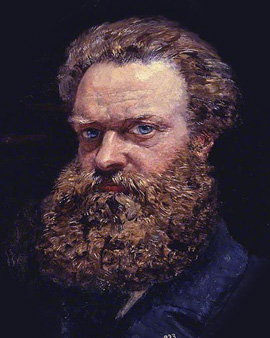John Brett was born in the small market town of Reigate in Surrey at the foot of the North Downs. His father, Charles Curtis Brett, was a surgeon and captain in the army. An older sister of the painter, Rose Brett was also a painter and the two siblings even shared a studio for some time. From Rosa Brett's diaries it is clear that the young woman initially even exhibited and sold her own paintings under her brother's name. John Brett first had private art lessons with the well-known landscape painter James Duffield Harding and also with the painter Richard Redgrave. At the age of 22 he began his studies at the Royal Academy of Arts. Here he met, among others, the well-known art critic and patron John Ruskin, who thought very highly of Brett's work and also supported him generously financially. Brett's first and probably most famous painting was called "The Stone Crusher" and depicted a boy who laboriously crushes stones for road construction. It was based on a painting with the same name that Henry Wallis had painted the year before in the Swiss Aosta Valley. Ruskin was so taken with Brett's work that he "donated" him a study stay in Switzerland and Italy. and even bought another painting by Brett, "The Aosta Valley", for himself.
John Brett became well known and very successful over time. He belonged to the circle of the Pre-Raphaelites and his works are on the one hand very detailed and atmospheric, but also often have a socially critical component. He visited Italy and Switzerland many times, where some of his best paintings were created, such as "The Glacier of Rosenlaui". Later on he also became more involved with marine and coastal themes. He owned a 210-ton schooner with a 12-man crew, with which he travelled the Mediterranean, partly with his family, but also along the coasts of England, Wales, Cornwall and the Isle of Wight in search of motifs. He also rented Newport Castle in Pembrokeshire for several summers to take trips to the Welsh coast, photograph, sketch and paint. John Brett was also an enthusiastic amateur astronomer.
×





.jpg)
.jpg)
.jpg)
.jpg)
.jpg)
.jpg)
.jpg)
.jpg)
_-_(MeisterDrucke-1324511).jpg)
_-_(MeisterDrucke-1324511).jpg)
.jpg)
.jpg)
.jpg)
.jpg)
.jpg)
.jpg)
.jpg)
.jpg)
.jpg)
.jpg)
.jpg)
.jpg)
_-_(MeisterDrucke-996023).jpg)
_-_(MeisterDrucke-996023).jpg)
.jpg)
.jpg)
.jpg)
.jpg)
.jpg)
.jpg)
_13th_December_1859_(pen_und_ink_on_paper)_-_(MeisterDrucke-38202).jpg)
_13th_December_1859_(pen_und_ink_on_paper)_-_(MeisterDrucke-38202).jpg)
.jpg)
.jpg)
.jpg)
.jpg)
 - (MeisterDrucke-70953).jpg)
 - (MeisterDrucke-70953).jpg)
.jpg)
.jpg)
_(oil_on_canvas)_-_(MeisterDrucke-1665114).jpg)
_(oil_on_canvas)_-_(MeisterDrucke-1665114).jpg)
.jpg)
.jpg)
.jpg)
.jpg)
.jpg)
.jpg)
_-_(MeisterDrucke-1665075).jpg)
_-_(MeisterDrucke-1665075).jpg)
_-_(MeisterDrucke-1665023).jpg)
_-_(MeisterDrucke-1665023).jpg)
.jpg)
.jpg)
.jpg)
.jpg)
_-_(MeisterDrucke-1131220).jpg)
_-_(MeisterDrucke-1131220).jpg)
.jpg)
.jpg)
 as a Child 1860 (watercolour on paper) - (MeisterDrucke-204139).jpg)
 as a Child 1860 (watercolour on paper) - (MeisterDrucke-204139).jpg)
.jpg)
.jpg)
.jpg)
.jpg)
.jpg)
.jpg)
.jpg)
.jpg)
_-_(MeisterDrucke-1131221).jpg)
_-_(MeisterDrucke-1131221).jpg)
.jpg)
.jpg)
.jpg)
.jpg)
.jpg)
.jpg)
.jpg)
.jpg)
.jpg)
.jpg)
_-_(MeisterDrucke-1665083).jpg)
_-_(MeisterDrucke-1665083).jpg)
.jpg)
.jpg)
.jpg)
.jpg)
.jpg)
.jpg)
.jpg)
.jpg)
.jpg)
.jpg)
.jpg)
.jpg)
_-_(MeisterDrucke-312011).jpg)
_-_(MeisterDrucke-312011).jpg)
.jpg)
.jpg)
.jpg)
.jpg)
.jpg)
.jpg)
_-_(MeisterDrucke-1131413).jpg)
_-_(MeisterDrucke-1131413).jpg)
.jpg)
.jpg)
.jpg)
.jpg)
.jpg)
.jpg)
.jpg)
.jpg)
.jpg)
.jpg)
.jpg)
.jpg)
.jpg)
.jpg)
.jpg)
.jpg)
.jpg)
.jpg)
.jpg)
.jpg)
.jpg)
.jpg)
.jpg)
.jpg)
.jpg)
.jpg)
.jpg)
.jpg)
.jpg)
.jpg)
.jpg)
.jpg)
.jpg)
.jpg)
.jpg)
.jpg)
_-_(MeisterDrucke-1128253).jpg)
_-_(MeisterDrucke-1128253).jpg)
.jpg)
.jpg)
.jpg)
.jpg)
.jpg)
.jpg)
.jpg)
.jpg)
.jpg)
.jpg)
.jpg)
.jpg)
.jpg)
.jpg)
.jpg)
.jpg)
.jpg)
.jpg)
.jpg)
.jpg)
.jpg)
.jpg)
.jpg)
.jpg)
.jpg)
.jpg)
.jpg)
.jpg)
_-_(MeisterDrucke-267642).jpg)
_-_(MeisterDrucke-267642).jpg)
.jpg)
.jpg)
.jpg)
.jpg)
_-_(MeisterDrucke-1126970).jpg)
_-_(MeisterDrucke-1126970).jpg)
.jpg)
.jpg)
.jpg)
.jpg)
_-_(MeisterDrucke-1131218).jpg)
_-_(MeisterDrucke-1131218).jpg)
.jpg)
.jpg)
.jpg)
.jpg)
.jpg)
.jpg)
.jpg)
.jpg)
.jpg)
.jpg)
.jpg)
.jpg)
_-_(MeisterDrucke-1129352).jpg)
_-_(MeisterDrucke-1129352).jpg)






